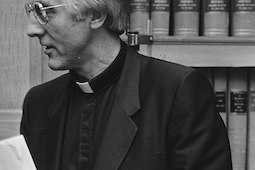Soaring on Eagles' Wings by Rievaulx Abbey

Grey Buzzard Eagle over Duncombe Park
I had a suitably joyful day on Gaudete Sunday, returning to the ruins of Rievaulx Abbey in North Yorkshire.
The afternoon would see a carol concert in the bare ruined choir, a popular annual tradition.
But before the crowds arrived, it was lovely to walk through the ancient stones, and seek to picture the glorious Cistercian monastery in its medieval heyday.
Pigeons, who had taken up station on the highest extant points of the abbey church, kept flying off in formation, wheeling through the air, before returning to their perch.
A falcon streaked through the grey sky, no doubt one reason for the pigeons' restlessness.
Perpendicular arches, tracery, pillars and some carved figures animated the lovely ruins here in the Rye Valley.
And truly this region is blessed with such places. Fountains, Byland and Jervaulx are all nearby, while 'young sprig' Benedictine Ampleforth is just a few miles away.
A small museum recounted the history of the foundation and the crucial importance of the abbeys in medieval society and culture. It also housed several other excellent artefacts and I was taken with the parade of tonsured Cistercians, with characterful expressions, who peopled the walls as if walking through the abbey's cloisters.
Rievaulx was the first Cistercian foundation in northern England, established it seems at the behest of St Bernard of Clairvaux; and St Aelred, one of the most charismatic of medieval monks, and the patron saint of friendship, was one of its earliest abbots.
English Heritage look after the site now and there is a fine shop, friendly staff and a cafe at the entrance.
A few miles away stands the bonnie market town of Helmsley, and it was its Lord, Walter Espec, who was the first patron of the abbey, back in 1131-32.
Next to the ruins of Helmsley Castle, and in the grounds of Duncombe Park, can be found the International Centre for Birds of Prey.
The centre, which only moved to its new site last year, boasts the largest collection of raptors in the north of England.
This was a bitingly cold, blustery day and so the afternoon display was kept short.
But it was eventful and glorious despite that.
A juvenile grey buzzard eagle (the species hails from South America) had trouble landing in nearby trees, and when hailed in to take a titbit, decided instead to treat a gentleman's black hat as his preferred prey. And the hat was atop the man's head.
Fortunately, the sharp talons did no harm though the buzzard eagle was loath to be parted from the titfer, mewing furiously when his handler sought to coax him off it.
Next up was Wrinkles, a beautiful great grey owl, with a moonlike facial disk and voluminous downy feathers, for the species haunts cold northern climes. In fact, the owl's body is surprisingly small beneath all the down. The disk aids in sonar detection, the great grey able to detect the slightest rodent movement up to 60cm beneath snow.
Wrinkles didn't approve of flying in the wind and took little hopping flights between her various staging posts, rewarded amply with titbits for her troubles.
Typhoon, on the other hand, was only too happy to take to the air. The rare New Zealand falcon came out with a little cap over his head to keep him calm. Once it was removed, and the lure was spun, he flew up and stooped, upped and stooped in a giddying, dizzying display of breathtaking flight. Charlie Heap, the centre's owner, struggled to whirl the lure out of the falcon's grasp.
A yellow-billed kite took food, tossed up in the air, with effortless ease, catching the morsels in its talons and passing them to its beak with fluent grace, just as it would despatch flying locusts in the wild.
The display over, I visited the host of raptors brought together from around the world. Florian the caracara was most demonstrative, with his bright beak, black crest, and histrionic calling. Several owls were silent and averted their gaze in seeming modesty, or haughtiness. Others uttered rasping cries, and two small white-faced owls appeared to be in an unnerving trance, rocking back and forth and uttering strange sounds, their eyes slits. Griffon vultures, booted eagles, buzzards, and burrowing owls, were just a few of the many beautiful and glorious species present here.
And while one might fret to think of them in their cages, it appears they are very well looked after, and the centre is dedicated to education, and conservation projects in several distant homelands of the birds.
Rievaulx and birds of prey, then, warmly recommended, even on a cold day.
Dr Philip Crispin is Lecturer in Drama at the University of Hull


















